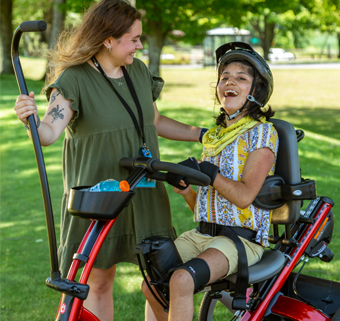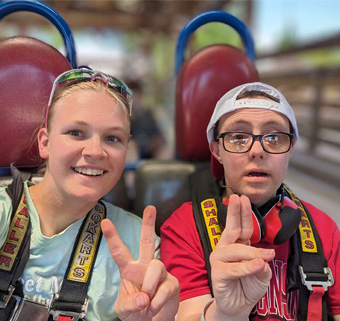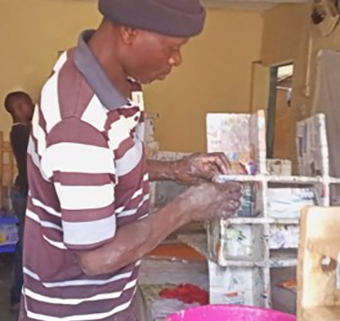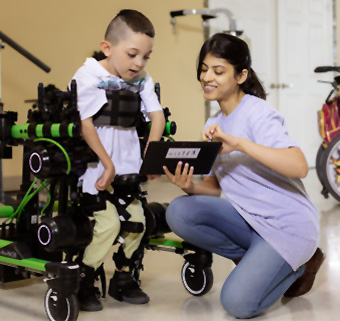Cory’s Dream
| June 2005
It was a perfect June evening in Paradise Valley, Montana. School was out, and for 17-year-old Cory Blough, a new chapter had just begun. His junior year behind him, he had moved out for the summer and was working at a dude ranch ten miles away. He was training horses – living his dream. He hopped up into his ’89 GMC pickup, and headed down the road to buy gas…
Fast forward an hour; Cory was drifting in and out of consciousness. According to the first witnesses at the scene of the accident, his truck had veered off the road about a mile from the ranch, flipping several times, and catapulting him from the cab. By the time the first EMTs got there, he was lying on the ground 150-200 feet away.
At first the doctors wondered if he’d make it at all. His spleen was lacerated, his left lung had collapsed, and his head injury was so severe that he had to be stabilized with an induced coma. He wasn’t to emerge for the next three months.
“After four weeks in the ICU,” his mother, Sandy, recalls, “they moved him to the neurology wing. They declined to give us a prognosis, but privately they marked his records PVS – persistent vegetative state.”
 As June turned to July, little changed. Two weeks after the accident, a trache-tube, feeding tube, and shunt to drain fluid around the brain were inserted, and at four weeks he was breathing on his own (though with additional oxygen). Now and then he’d open or shut an eye, or make a slight motion. But that was it.
As June turned to July, little changed. Two weeks after the accident, a trache-tube, feeding tube, and shunt to drain fluid around the brain were inserted, and at four weeks he was breathing on his own (though with additional oxygen). Now and then he’d open or shut an eye, or make a slight motion. But that was it.
Then, one day about twelve weeks after the accident, Cory laughed when a family friend recounted an old story. “That was one of the first signs that he knew what was going on around him,” his father, Kent, says. “That, and the thumbs up he gave us one day. It was completely unexpected.”
All the same, it may have been a reward. Because even though the hospital staff urged Kent and Sandy to go home – “Don’t feel guilty. You need time for yourselves” – they had never once left Cory’s side.
 “Even when he was comatose, we tried to stimulate his mind,” says Kent. “We played music he liked. We read him books, and stories from the Bible. We enlarged pictures of his friends and his horse and plastered them around his bed.”
“Even when he was comatose, we tried to stimulate his mind,” says Kent. “We played music he liked. We read him books, and stories from the Bible. We enlarged pictures of his friends and his horse and plastered them around his bed.”
In August, Cory was moved to a nursing home. “The hospital couldn’t do any more for him,” Sandy says, “and we didn’t have the means to care for him at home. We had tried every place we could think of – Mayo Clinic in Rochester, Craig Institute in Denver. But no one would take him.” Then Benefis Healthcare turned up.
A not-for-profit hospital in Great Falls, three hours away, Benefis was Cory’s home for most of the next five months. Progress was slow, and not continuous: he’d painstakingly master a move one day but be unable to repeat it the next.
 Just learning to eat was an arduous process. He began with swallowing droplets of milk in August, and it was January by the time he was practicing with real food.
Just learning to eat was an arduous process. He began with swallowing droplets of milk in August, and it was January by the time he was practicing with real food.
It was heartbreaking to watch, especially for people who knew him “before.” Less than a year earlier, as a member of a high school rodeo team, Cory had been roping, wrestling steers, and riding bulls. In the latter sport, he’d come in fifth in a statewide competition. Ironically, he’d also given it up – just two months before the accident. “I love riding bulls,” he told his parents, “but it’s too dangerous.”
Things began to speed up after Cory’s homecoming on January 26, 2005. By March he was going to therapy daily, and even attending school two half-days a week. (He has since re-learned the days of the week and how to tell time, and is now doing simple math.)
In April, Kent asked Cory’s therapist about getting a gait trainer, and soon Cory was using a Rifton Pacer. “Until then, the only way he could move was with a walker,” says Sandy. “He needed two or three people to assist him, and even then we were worried he’d fall. But once he’s strapped in a gait trainer, he only needs one of us. And I’m no longer nervous, because I know he’s safe.”
 By May, Cory was learning to lift first one leg and then the other. “Before, his right leg always buckled,” his mother says. “But with the gait trainer he’s gained in confidence and ability. The other day he bent both knees at once, and straightened both – on command! It was a huge achievement. We were all excited.”
By May, Cory was learning to lift first one leg and then the other. “Before, his right leg always buckled,” his mother says. “But with the gait trainer he’s gained in confidence and ability. The other day he bent both knees at once, and straightened both – on command! It was a huge achievement. We were all excited.”
According to Kent, the gait trainer has done more as well. “It’s changing his spirit. He smiles more when he’s in it. He communicates more. When I get him up in the morning and ask him, ‘What do you want to do today?’ his first response is always, ‘Walk!’”
As the first anniversary of their son’s accident comes and goes, Kent and Sandy are exploring the prospects of equine therapy. When they talk to Cory about the idea, his face immediately breaks into a grin. “Ride horses!” he says excitedly. He is still living his dream. But with his Rifton Pacer, and with the help and love of those around him, why shouldn’t it become a reality again? As an ancient Chinese proverb reminds us, even the longest journey begins with a single step.




